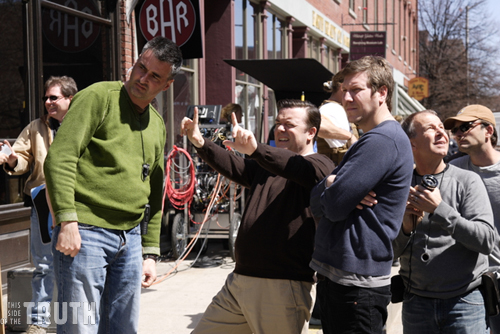I Don’t Think We’re In Hollywood Anymore: Television Series Go On Location
Alisa Perren / Georgia State University

Recently, I tuned in to the pilot of In Plain Sight, a new drama on the USA network. Little about the plot or characters stood out. However, one element did catch my eye: the show’s scenic setting in Albuquerque, New Mexico. The area’s distinctive architecture and landscape are among the program’s most striking components.
An effective use of a location is scarcely enough to draw me back for repeat viewings. However, its effective backdrop did lead me to think about how several recent shows have taken advantage of settings outside the traditional New York-Los Angeles axis. From Burn Notice and Dexter (Miami) to Friday Night Lights (central Texas) to One Tree Hill (Wilmington), many television programs seem to be using their surroundings effectively to help set the tone, advance the story, and define the characters.

This leads me to ask a couple of questions: To what extent is the movement to other parts of the U.S. a new development? And if so, why does it seem to be happening now?
Certainly fictional television series long have been located in locales outside of New York and Los Angeles. One can point to a number of programs – from The Dukes of Hazzard (Georgia) to Dynasty (Colorado) to Cheers (Boston) and That ‘70s Show (Wisconsin) that have been set elsewhere. Yet for the most part, with the exception of recycled establishing shots and a handful of “special” episodes, all of these shows were still filmed predominantly on soundstages and in locations across Los Angeles.

Lately, however, a growing number of shows – especially cable shows – are taking advantage of “real” locations outside of New York and L.A.2 “Locals” are serving as extras and bit part players; shoots occur in city restaurants and shops. In addition, local resources such as production crews and office facilities are employed on a consistent basis.
This takes us to the real reason many of these shows are moving away from the “coasts”: state incentive programs. In the last few years, throughout the U.S., state and local governments have become more and more aggressive in giving tax credits, rebates and grants as incentives offered to recruit production companies for local shoots. In the past few months alone, a wide range of states including Connecticut, Wisconsin, Michigan, Georgia and Massachusetts have passed new legislation designed to bring in more production.3

State representatives and local businesses have long viewed the recruitment of Hollywood productions as desirable. Of course there is the obvious economic motivation. Not only do local productions serve as a potential low-cost way of promoting an area and bringing in tourism, but the crews themselves bring money to the area’s economy by frequenting local businesses. For example, Georgia believes that media productions contributed $475 million to its economy in 2006; Connecticut estimates that $400 million in production costs have come into the state from July 2006 to March 2008.4
There are also less tangible but equally powerful motivations for developing incentive programs. These include everything from politicians wanting to hobnob with celebrities who are in town during the shoot to business bureaus seeing the publicity attached to a large-scale production as an efficient way of enhancing a city or region’s image.
Typically these incentive programs have been – and continue to be – focused on attracting feature-length films. In the past not only have movie productions been more amenable to shooting on location than television series but they also have carried a mystique and cultural cachet for outsiders that television series have not. Yet though there may be more allure attached to attracting a high-profile Will Smith or Julia Roberts shoot, a successful series television show can prove a much bigger boon to a local economy in the long term. A hit series can last years, bringing in consistent revenue to a community for a much longer period of time than even the biggest budgeted feature film.
Nontheless, until recently, series television has been much less likely to hit the road. When these shows did “run away” from Hollywood, they usually did so to take advantage of the incentives in other countries, especially Canada, New Zealand and Australia. The types of shows that were most likely to leave the States were either the science fiction/fantasy variety (Xena: Warrior Princess, Battlestar Galactica) or those that, for economic reasons, sought to maintain the fiction that they were set in a U.S. city and worked hard to conceal their non-U.S. locations onscreen (21 Jump Street, The X-Files).

Yet now things are changing – and they are changing quickly. Suddenly a wider range of programs are departing from Southern California soundstages and spreading across the country. The reasons for this are many: The dollar is getting weaker by the day, thus taking away much of the motivation to shoot television series outside the States much less attractive. Further, as noted above, each U.S. state seems eager to outbid the next to draw as many productions as possible. Meanwhile, TV production companies are more willing to consider the move due to the changing economics of television, including higher production costs and a greater need in this emerging post-network era for greater product differentiation in stories and settings.
Which brings us back to In Plain Sight. New Mexico has been mentioned often as one of the states that has most heavily recruited Hollywood productions in recent years. Now it seems that these efforts are starting to pay off. While luring one production is unlikely to jump-start a local media scene, it can help build a strong foundation by developing skilled crews and a solid infrastructure.5
Though this is certainly a promising development from an economic perspective, I want to call attention once again to the idea with which I began this column: that the rise in production in places across the U.S. offers more than just the prospect of cultivating a wider range of media centers. Rather, it also promises the possibility of representing the complexities and nuances of this country, its people, and its settings on a weekly basis, in ways which have not been seen before. Right now this is more of a hope than a certainty – but it seems to be something “in plain sight.”
Image Credits:
1. In Plain Sight in New Mexico.
2. Burn Notice: Palm Trees, Bikinis..must be Miami.
3. The “real” Cheers bar was located on a soundstage on the Paramount lot in Hollywood.
4. Ricky Gervais taking advantage of Massachusetts production incentives for This Side of the Truth.
5. 21 Jump Street: Just a couple of American cops…in Vancouver.
Please feel free to comment.
- It is worth noting that Miami Vice used similar locales quite effectively a couple decades ago. [↩]
- Programs on cable and smaller networks such as the CW seem more likely to shoot outside of Los Angeles in order to keep their budgets down and the production values up. [↩]
- With so many states competing for local productions, it will be interesting to see which are able to attract the most productions. For discussions of recent incentive packages see: Bashirah Muttalib, “Georgia Offers Juicy Tax Credits,” Variety, http://www.variety.com/article/VR1117986920.html?categoryid=8&cs=1; Lisa W. Foderaro, “Gone with the Cash: Films Go for the Best Tax Breaks,” New York Times, http://www.nytimes.com/2008/03/29/nyregion/29film.html?_r=1&scp=11&sq=film+incentives&st=nyt&oref=slogin, Matthew Ross, “American Rebates Bloom,” Variety, http://www.variety.com/index.asp?layout=festivals&jump=features&id=3073&articleid=VR1117985361; Glenn Rifkin, “Lights, Camera, Tax Credit: Massachusetts Lures Filmmakers with Generous Rebate,” New York Times, http://www.nytimes.com/2008/06/05/business/smallbusiness/05sbiz.html?partner=rssnyt [↩]
- “Georgia Offers Juicy Tax Credits” and “Gone with the Cash.” [↩]
- For a discussion on the impact of television production on Vancouver, see Serra Tinic, On Location: Canada’s Television Industry in a Global Market, University of Toronto Press, 2005. For a discussion of its impact in Queensland, Australia, see Tom O’Regan and Susan Ward, “Experimenting with the Local and Transnational: Television Drama Production on the Gold Coast,” Journal of Media and Cultural Studies, vol. 20, no. 1 (March 2006), 17-31. [↩]
After reading this, I can’t help but think of HBO’s The Wire in which Baltimore–as a geographical location and as a civil network comprising various public institutions–is one of the primary subjects of the series. Far different from shows you mention that choose location for financial incentives (or other examples like the multiple incarnations of CSI which rely on a location change to continue the franchise), The Wire seems to fit into the category you mention at the very end of your column – shows that rely on geographical specificity to contribute to create richer, more complex stories. I only hope more shows use their location likewise in the future.
I think that the focus in this column on tax incentives is spot-on, but I wonder whether or not some of the diffusion of television (and film production) outside of the NY/LA orbit owes something to technological innovation. Living in Texas, it’s hard not to be aware of Marfa as an attractive destination for filmmakers. Recently, of course, No Country for Old Men and There Will be Blood have utilized that west Texas locale, but Giant was shot there half a century ago as well. When George Stevens shot that film, however, it required the wholesale importation of the Hollywood studio system into the desert. With digital video and PC-based post-production, I’d imagine that the tax incentives are that much more compelling for film and TV producers looking to keep their projects under budget. Of course, the kind of audience support that a local production garners within that city or region can’t hurt either. Great work.
I really enjoyed this article. Just for fun, I thought I’d offer a link to the analysis for Texas HB 1634, a bill which recently sought to expand Texas’ own stake in the Film/TV production industries through an incentive program (it passed eventually). I think the opposing legislators’ concerns about the program are particularly interesting. Considering the article’s closing suggestion that the programs promise “the possibility of representing the complexities and nuances of this country, its people, and its settings on a weekly basis, in ways which have not been seen before,” what, then, are the implications of a Texas state representative saying something like “The state of Texas is not in the business of moving image production. The industry is made up of private businesses and is region-specific?” This rationale strikes me as strange, as it seems to be appealing to some “common sense” notion of which regions do and do not “belong” in the business of producing moving images.
On the other hand, what about the additional incentives for productions in “underused areas” that this particular bill stipulates?
http://209.85.215.104/search?q.....=firefox-a
Great article – I was reminded it of it when I caught a story on the local news tonight. WXYZ, Detroit, reported on the filming of a pilot for ABC. The interview with locals about their experiences as extras is particularly notable. What is interesting about the ways that these shows might construct or capture place in a more nuanced way, is how these shows might figure in the way “locals” themselves imagine their newly publicized communities.
I’m not sure how long this will be up, but you can check out the story at http://www.wxyz.com/news/local.....2e9e7a62f1
Of course, Detroit was an early center of radio production – WXYZ radio originated the Lone Ranger and the Green Hornet.
Enjoyed reading this. Folks might want to look at our books Global Hollywood (2001) and Global Hollywood 2 (2005), both from the British Film Institute/University of California Press, which detail these topics both in terms of US-based film and TV and offshore production.
Best
Toby
Woops–I somehow forgot to mention other good sources on this topic that might interest readers–sorry–a wee bit narcissistic only to commend one’s own books! Here are some other key recent sources on this topic. We still need a lot more work on the massive subsidies from states and municipalities in the US that characterize our Hollywood’s laughable claims to being laissez-faire, quite apart from its rorting of other nations’ coffers
Toby
Contracting Out Hollywood: Runaway Productions and Foreign Location Shooting. Ed. Greg Elmer and Mike Gasher. Lanham: Rowman & Littlefield, 2005.
Brett Christophers, “Media Geography’s Dualities.” Cultural Geographies 14, no. 1 (2007): 156-61
___, “Underpopulation, Television Economies, and the Power of the Geographical Imagination.” Geografiska Annaler Series B-Human Geography 89B, no. 1 (2007): 39-51
Susan Christopherson, “Behind the Scenes: How Transnational Firms are Constructing a New International Division of Labor in Media Work.” Geoforum 37, no. 5 (2006): 739-51
Andrew Dawson, ““Bring Hollywood Home”!: Studio Labour, Nationalism and Internationalism, and Opposition to ‘Runaway Production’, 1948-2003.” Revue Belge de Philologie et d’Histoire 84, no. 4 (2007): 1101-122
Mark Deuze, Mediawork. Cambridge: Polity Press, 2007
Allen J. Scott, “Hollywood and the World: The Geography of Motion-Picture Distribution and Marketing.” Review of International Political Economy 11, no. 1 (2004): 33-61
___ and Naomi E. Pope, “Hollywood, Vancouver, and the World: Employment Relocation and the Emergence of Satellite Production Centers in the Motion Picture Industry.” Environment and Planning A 39, no. 6 (2007): 1364-81
Pingback: “Thin Line ‘tween heaven and here” (Bubbles): Real and Imagined Space in The Wire | darkmatter Journal